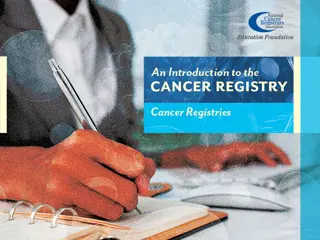Understanding the Fundamentals of Carcinogenesis and Cancer Hallmarks
Carcinogenesis involves non-lethal genetic damage, clonal expansion of precursor cells, and multi-step processes, with the involvement of normal regulatory genes. The hallmarks of cancer include self-sufficiency in growth signals, insensitivity to inhibitory signals, evasion of cell death, replicative potential, sustained angiogenesis, and invasive capabilities. Genetic mutations, clonal expansion, accumulation of mutations, and involvement of regulatory genes are key factors in the development of cancer. Transformation of proto-oncogenes into oncogenes through various mechanisms like point mutations, chromosomal translocations, and gene amplifications play a significant role in oncogenesis.
Download Presentation

Please find below an Image/Link to download the presentation.
The content on the website is provided AS IS for your information and personal use only. It may not be sold, licensed, or shared on other websites without obtaining consent from the author. Download presentation by click this link. If you encounter any issues during the download, it is possible that the publisher has removed the file from their server.
E N D
Presentation Transcript
Lec: Carcinogenesis o 1
HALLMARKS OF CANCER Self-sufficiency in growth signals Insensitivity to growth inhibitory signals Evasion of cell death Limitless replicative potential Development of sustained angiogenesis Ability to invade and metastasize
some fundamental principles : 1-non-lethal genetic damage (mutation) 2-The tumor is the result of clonal expansion of a single precursor cell 3-Carcinogenesis is a multi-step process: Phenotypic (tumor progression) genetic ( accumulation of mutations) 4- Involvement of normal regulatory genes 3
: I 4
1 Non-lethal genetic damage (mutation) A.Acquired through the action of environmental factors: radiation, chemicals or viruses. e.x HPV associated with cancer of the cervix B. Inherited in germ line cells. e.x Familial adenomatous polyps (APC gene, autosomal dominent disorder) 5
2The tumor is the result of clonal expansion of a single precursor cell. 3Multistep carcinogenesis: Phenotypic (tumor progression), genetic (accumulation of mutations) 6
4-Involvement of normal regulatory genes: A: The growth promoting genes (proto- onco-genes.) B: The growth inhibiting genes (cancer suppressor genes.) C: Genes that control programmed cell death (apoptosis.) D: DNA repair genes. 7
Transformation of proto-oncogenes to oncogenes: -point mutation -Chromosomal translocation (philadelphia chromosome in chronic myeloid leukaemia) -Amplification (myc gene, HER2 gene) Al-Madena Copy CLS Patho 8
Chromosomal translocations The chromosomal translocations and associated oncogenes in Burkitt s lymphoma and chronic myelogenous leukemia Pheladelphia chromosome Al-Madena Copy CLS Patho 9
Rb gene P53 gene TGF-beta NF-1 Al-Madena Copy CLS Patho 10
-4DNA repair genes Xeroderma pigmentosum, or XP, is genetic disorder of nucleotide excision repair damage caused by ultraviolet (UV) light is deficient repair mechanism ability to Children of the Night Photosensitivity Skin lesions & changes skin cancer at early age Al-Madena Copy CLS Patho 11
-- 0 Z O O M 12
TYPES OF CARCINOGENS Three main types: Chemical Direct acting Indirect acting Physical (radiation) Biological (especially virus) nitrosoureas yl chloride CHEMICAL CARCINOGENS Direct-acting Weak carcinogens Require no chemical transformation Alkylating agents Cyclophosphamide, chlorambucil, Acylating agents - Acetyl-imidazole, Dimethylcarbam CHEMICAL CARCINOGENS Indirect-acting Require metabolic conversion before they become active. Aromatic amines and azo dyes - Beta-naphthylamine: Bladder CA in rubber factories - Azo dyes used in food color Aflatoxin B( Aspergillus in grains: Hepatocellular cancer) Polycyclic hydrocarbons: fossil fuels, cigarette smoke 13
Physical carcinogenesis Physical carcinogenesis I I I Non-radiation l Physical Carcinogenesisj radiation Physical Carcinogenesis Radiation I I I Ultraviolet light Ionising radiation 14
DNA viruses: HPV= Human papilloma virus (cancer of cervix) HBV = hepatitis B virus Herpes viruses (EBV, HSV1 & 2, KSV) EBV= Epstein Barr Virus (Burkitt lymphoma, Nasopharyngeal carcinoma) HSV (type 1 &2): Cancer of cervix KSV (kapossi sarcoma) RNA viruses: HTLV -1=Human T-cell lymphotropic virus type1 (adult T-cell leukemia/lymphoma( HCV 15
Summary Cancer results from clonal expansion Carcinogenesis is a multistep process Four groups of normal regulatory genes are involved in carcinogenesis Tumour suppressor gene (P53 & Rb) play important role in the control of cell growth Three main types of carcinogens Chemical Direct acting Indirect acting Physical (radiation) Biological (especially virus) 16























